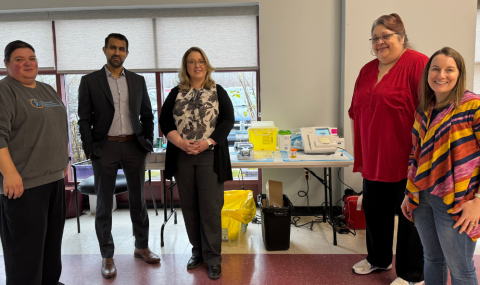Procedure for Drawing Aminoglycoside Levels
|
Levels are indicated to determine if the correct dose is being administered, as per the patient's weight and volume of distribution, and if the dosing interval is appropriate for the patient's renal function. These agents have significant renal toxicity, particularly when serum concentrations are excessive. Inadequate levels provide inadequate gram-negative coverage. | | Procedure | | 1. | Apply Related Procedures and Policies Refer to the procedure or blood sampling from an indwelling line as indicated. | | 2. | Timing of Pre Drug Level For patients receiving traditional Q8H or Q12H dosing, draw pre and post levels with the THIRD dose of aminoglycoside (or as per order). Draw "pre" level within 30 minutes prior to the next scheduled drug dose. (eg., if drug is due at 0800 hours, "pre" level is drawn between 0730-0800 hours, before the drug is hung). This will reflect the lowest serum concentration. For patients receiving different dosing regimens (such as once daily), a single random drug level is usually ordered (no pre or post level). | | 3. | Drug Administration Time Administer the drug by IV infusion over precisely 60 minutes
(e.g., infuse from 0800-0900 hours). Upon completion, hang a bag of saline and administer a 20 ml piggyback bolus. DO NOT back flush the piggyback line as a method of drug clearance. Steady infusion over 60 minutes prevents high peak serum concentrations. Back flushing may leave a small amount of drug within the "Y" connection. Any aminoglycoside that remains in the tubing would be administered with subsequent IV infusions. If an infusion is started just prior to drawing the post level, falsely high peak serum concentrations may be obtained. | | 4. | Timing of Post Drug Level Draw "post" aminoglycoside level precisely 30 minutes post completion of infusion (eg. at 0930 hours). The distribution phase is completed by this time. Waiting any longer to obtain post level would miss the true maximal serum concentration, resulting in a falsely low level. Drawing the level too soon would measure within the distribution phase, resulting in a falsely high level. For patients receiving different dosing regimens (such as once daily), a single random drug level is usually ordered (no pre or post level). | | 5. | Lab Order When ordering the lab test, enter the infusion start time and end time (discontinue time). Under comments section at the bottom of the screen (NOT under "label"), make a notation of the actual time that the level was drawn. If unable to draw levels at these times, ensure exact times are recorded on lab requisition. If exact times are recorded, pharmacokinetic calculations can be done to estimate true levels. The lab will assume that the sample was drawn at the time the label was printed. This can lead to interpretation error. Comments entered in the "label" section are not saved in the lab system; these comments only appear on the label to facilitate correct tube placement. NOTE:
If the drug infused over a different time period (e.g., 30 minutes) or was measured at a different time in relation to completion of the drug administration (e.g., 1 hour post), accurate interpretation depends upon correct recording of the method of collection. It is more important to accurately document the time of the measurement, than to obtain at 30 minutes. | | 6. | Communication Communicate results to physician and pharmacist.
Pre-dose levels are used to determine the appropriate dosing interval. Post-dose levels are used to determine the appropriate dose. |
|
November, 1988
Last Update: January 29, 2020, Reviewed: January 17, 2025
Brenda Morgan, Clinical Educator, CCTC
Lynne Kelly, Clinical Pharmacist, CCTC |


